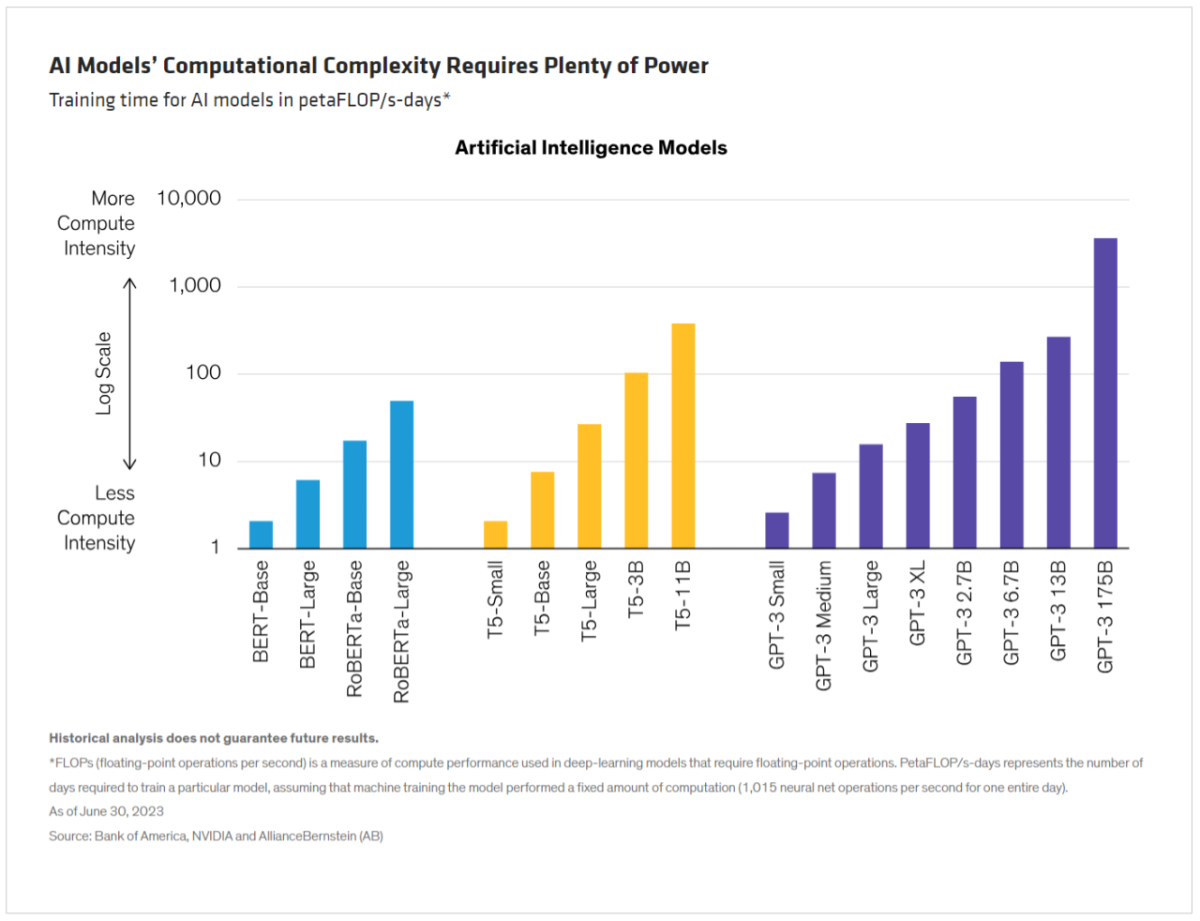AB: Energy Addiction: AI’s Next Big Challenge
Investors should take a closer look at companies that help create a more energy-efficient ecosystem for AI.
Published 09-06-23
Submitted by AllianceBernstein

By Daniel C. Roarty, CFA| Chief Investment Officer—Sustainable Thematic Equities and Ben Ruegsegger, CFA| Portfolio Manager—Sustainable US Thematic; Senior Research Analyst—Sustainable Thematic Equities
There’s a big buzz around artificial intelligence (AI) and its potential to change the world. But much less has been said about its energy footprint. Companies that help solve this energy conundrum could enable a sustainable future for this burgeoning technology—and create opportunities for equity investors.
What’s known as “generative” AI uses machine learning to generate content—including text, audio, video and images. OpenAI’s wildly popular ChatGPT is perhaps the most well-known example. There are countless applications for generative AI, from academic writing to audio and video editing to scientific research. Companies everywhere are hunting for AI applications that can enhance productivity and create business benefits in industries ranging from healthcare to investment management.
But here’s the rub: AI requires massive computational power to train models. And that raises a thorny issue—namely, the energy impact of AI.
Generative AI Is an Energy Hog
What’s behind the magic of machine learning? There are two primary stages. The first is training, which involves gathering information so that machines can learn everything possible to create a model. The second is inference, whereby the machine uses that model to generate content, analyze new data and produce actionable results.
All of this requires energy. The more powerful and complex the AI model, the greater the training time and energy required (Display).
OpenAI’s GPT-3 model is illustrative. The energy needed to train GPT-3 could power an average American’s home for more than 120 years, according to a report from Stanford University. Meantime, Bay Area chipmaker NVIDIA notes that energy requirements for training models that include transformers—a form of deep-learning architecture—have increased by 275 times every two years.
The Many Sources of Energy Consumption
AI’s energy consumption will come from many corners. In addition to training and running large models, the proliferation of AI-assisted products, including AI search and chatbots, will gobble up terawatts.
Increasingly complex models will, in turn, require the use of more specialized hardware, such as graphic processing units (GPUs). The good news is that GPUs deliver much more performance-per-watt than traditional central processing units (CPUs), which could offset the overall power requirements to train and run AI models.
Ultimately, these drivers of energy consumption will accelerate the construction of power-hungry data centers, which already account for nearly 1% of global energy use, according to the International Energy Agency. Even before AI began to take off, studies predicted a sharp increase in data center construction, driven by the energy needs of new technologies.
There’s also the issue of emissions to consider. In particular, investors are pushing companies to measure Scope 3 emissions—upstream and downstream emissions that can be difficult to quantify. As AI use increases, the Scope 3 emissions of all data users—including firms that traditionally have low carbon footprints—are likely to grow correspondingly.

How Are Companies Addressing the AI Energy Conundrum?
Fortunately, companies are beginning to address the enormous AI energy challenge. These include firms that are central to AI and those only nibbling at the periphery. We think investors should pay attention to three key areas:
Hardware and Software: Reducing AI-related energy use will require new processor architectures. US semiconductor makers like AMD and NVIDIA are focused on delivering more energy-efficient performance. In fact, AMD has set a goal of increasing the energy efficiency of its processors and accelerators used in AI training and high-performance computing by 30 times over a five-year period. According to NVIDIA, its GPU-based servers in some applications, such as large-language model training, use 25 times less energy than CPU-based alternatives. As GPUs from AMD, NVIDIA and others take share from CPUs in data centers, energy efficiency should increase even further.
Conserving energy will also require advanced transistor-packaging techniques. Technologies such as dynamic voltage frequency scaling and thermal management will be required to produce more efficient machine learning. We believe companies involved in semiconductor chip production and inspection, including Taiwanese chipmaker TSMC and Netherlands-based ASML, will have a significant role to play in bringing these new innovations to market.
Investors will also be hearing more about power semiconductors, which help improve the power management of AI servers and data centers. Power semiconductors regulate current and can lower overall energy use by integrating more functionality in smaller footprints. Firms like Kirkland, Washington-based Monolithic Power Systems and German semiconductor manufacturer Infineon Technologies are at the forefront of their development, in our view.
Improvements in Data Center Design: As AI adoption fuels the expansion of data center capacity, firms that supply data center components could reap benefits. Key components include power supplies, optical networking, memory systems and cabling. Tech companies that use the data centers themselves—think Amazon.com, Google and Microsoft—also have a strong incentive to continue improving data center design and energy consumption.
Coming full circle, AI itself is being used to optimize data center operations. In 2022, Google DeepMind released the results of a three-month experiment that involved training a learning agent called BCOOLER to optimize Google’s data center cooling procedures. The result: BCOOLER achieved roughly 13% energy savings—underscoring that energy efficiency is improving in data centers, even as their numbers grow.
Renewable Energy: Renewables made up 21.5% of US electricity generation in 2022, according to the Energy Information Administration. With 80% of the US power grid nonrenewable, near-term power could come from traditional fossil fuels.
But over time, AI demand could open the door for more renewable energy use. That’s especially true given that AI data centers will be operated by the likes of Microsoft and Google’s parent company, Alphabet, Inc., whose net zero policies are among the industry’s best. As a result, we expect that accelerated adoption of AI could improve the investment prospects of the entire renewable-power ecosystem.
Investing in Energy Solutions
In all these areas, we believe that investors should search for quality companies with a technological advantage, persistent pricing power, healthy free-cash-flow generation and resilient business models. Companies with strong fundamentals that are poised to participate in and benefit from increased demand for energy-efficient AI capabilities could provide attractive opportunities for equity investors with a sustainable focus and those with an absolute-return mandate.
As AI adoption accelerates and search engines are replaced by chatbots, the energy impact of this revolutionary form of machine learning should not be overlooked. Initiatives aimed at creating a more energy-efficient AI ecosystem might not be in the spotlight now, but they could eventually unlock attractive return potential for investors who can spot the potential solutions early.
Claire Walter, Research Analyst—Sustainable Thematic Equities, contributed to this analysis.
The views expressed herein do not constitute research, investment advice or trade recommendations and do not necessarily represent the views of all AB portfolio-management teams. Views are subject to revision over time.
Learn more about AB’s approach to responsibility here

AllianceBernstein
AllianceBernstein
AllianceBernstein (AB) is a leading global investment management firm that offers diversified investment services to institutional investors, individuals, and private wealth clients in major world markets.
To be effective stewards of our clients’ assets, we strive to invest responsibly—assessing, engaging on and integrating material issues, including environmental, social and governance (ESG) considerations into most of our actively managed strategies (approximately 79% of AB’s actively managed assets under management as of December 31, 2024).
Our purpose—to pursue insight that unlocks opportunity—describes the ethos of our firm. Because we are an active investment manager, differentiated insights drive our ability to design innovative investment solutions and help our clients achieve their investment goals. We became a signatory to the Principles for Responsible Investment (PRI) in 2011. This began our journey to formalize our approach to identifying responsible ways to unlock opportunities for our clients through integrating material ESG factors throughout most of our actively managed equity and fixed-income client accounts, funds and strategies. Material ESG factors are important elements in forming insights and in presenting potential risks and opportunities that can affect the performance of the companies and issuers that we invest in and the portfolios that we build. AB also engages issuers when it believes the engagement is in the best financial interest of its clients.
Our values illustrate the behaviors and actions that create our strong culture and enable us to meet our clients' needs. Each value inspires us to be better:
- Invest in One Another: At AB, there’s no “one size fits all” and no mold to break. We celebrate idiosyncrasy and make sure everyone’s voice is heard. We seek and include talented people with diverse skills, abilities and backgrounds, who expand our thinking. A mosaic of perspectives makes us stronger, helping us to nurture enduring relationships and build actionable solutions.
- Strive for Distinctive Knowledge: Intellectual curiosity is in our DNA. We embrace challenging problems and ask tough questions. We don’t settle for easy answers when we seek to understand the world around us—and that’s what makes us better investors and partners to our colleagues and clients. We are independent thinkers who go where the research and data take us. And knowing more isn’t the end of the journey, it’s the start of a deeper conversation.
- Speak with Courage and Conviction: Collegial debate yields conviction, so we challenge one another to think differently. Working together enables us to see all sides of an issue. We stand firmly behind our ideas, and we recognize that the world is dynamic. To keep pace with an ever changing world and industry, we constantly reassess our views and share them with intellectual honesty. Above all, we strive to seek and speak truth to our colleagues, clients and others as a trusted voice of reason.
- Act with Integrity—Always: Although our firm is comprised of multiple businesses, disciplines and individuals, we’re united by our commitment to be strong stewards for our people and our clients. Our fiduciary duty and an ethical mind-set are fundamental to the decisions we make.
As of December 31, 2024, AB had $792B in assets under management, $555B of which were ESG-integrated. Additional information about AB may be found on our website, www.alliancebernstein.com.
Learn more about AB’s approach to responsibility here.
More from AllianceBernstein

